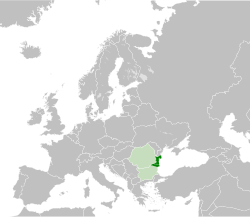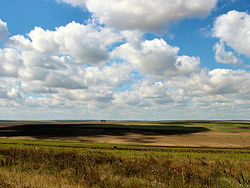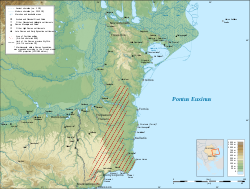Dobruja
Dobruja or Dobrudja (US: /ˈdoʊbrʊdʒə/;[1] Bulgarian: [Добруджа] Error: {{Lang}}: text has italic markup (help) or Dobrudža; Romanian: Dobrogea, pronounced [ˈdobrodʒe̯a] (![]() listen) or [doˈbrodʒe̯a]; Turkish: [Dobruca] Error: {{Lang}}: text has italic markup (help)) is a region between Bulgaria and Romania. It is found between the Danube and the Black Sea. It is divided between Northern Dobruja in Romania and Southern Dobruja in Bulgaria.
listen) or [doˈbrodʒe̯a]; Turkish: [Dobruca] Error: {{Lang}}: text has italic markup (help)) is a region between Bulgaria and Romania. It is found between the Danube and the Black Sea. It is divided between Northern Dobruja in Romania and Southern Dobruja in Bulgaria.
The Romanian part of Dobruja, Dobrogea, is made up of the counties of Constanţa and Tulcea. The Bulgarian part of Dobruja, Dobrudzha, is made up of the provinces of Dobrich and Silistra.
Major cities in Dobruja include Constanța, Tulcea, Medgidia and Mangalia in the Romanian part and Dobrich and Silistra in the Bulgarian part.
Geography
Dobruja is a mainly hilly area except for the marshy Danube Delta. It has an average altitude of about 200–300 metres. Its highest point is the Țuțuiatu (Greci) Peak in the Măcin Mountains, with a height of 467 m. The Romanian part of Dobruja is covered mostly by the Dobruja Plateau. The Bulgarian part has the Ludogorie Plateau. Lake Razelm is one of the most important lakes in Northern Dobruja. Dobruja has a continental climate.
Dobruja is a windy region known for its windmills. There is wind during about 85–90% of all days. It usually comes from the north or northeast. The average wind speed is about twice higher than the average in Bulgaria.
Dobruja Media
Dobruja (dark green) within Bulgaria and Romania (light green), both in Southeast Europe.
The first Greek colony in the region, Histria
The Tropaeum Traiani monument in Adamclisi commemorating Roman victory over Dacians (Modern reconstruction)
References
- ↑ "Dobruja". Collins English Dictionary. HarperCollins. Retrieved 21 July 2019.
| Wikimedia Commons has media related to Lua error in Module:Commons_link at line 62: attempt to index field 'wikibase' (a nil value).. |









